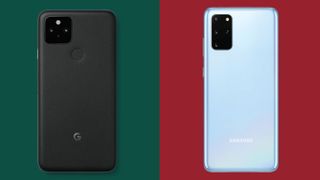
The Google Pixel 5 and the Samsung Galaxy S20 are two of the most high profile flagship phones of 2020, from two of the biggest names in the smartphone business.
If you were to select a single phone to represent the whole Android platform, both of these phones would have a good shot. Samsung makes the most popular and feature-packed Android phones on the market, while Google is the creator of Android itself.
Because of these facts, you might expect the Pixel 5 and the Galaxy S20 to provide similar offerings. However, they take remarkably different routes to Android excellence.
Still, there can be only one winner in this clash of styles. There’s a lot to unpack here.
Google Pixel 5 vs Samsung Galaxy S20 price and availability
As is Samsung’s wont, the Samsung Galaxy S20 was one of the earliest flagship contenders of 2020, having landed in stores way back on March 6, following a February announcement.
Google arrived typically late to the party with its own flagship phone, with the Pixel 5 made available on October 15. You’d expect this 7-month split to manifest in a technological advantage for the Pixel, but as we’ll go on to discuss, that’s not the case at all.
In pricing terms, the Samsung Galaxy S20’s starting RRP stands at £799 / AU$1,349. If you’re wondering where our US pricing is, there simply is none, because this entry-level 4G Galaxy S20 was never released in the States.
Get daily insight, inspiration and deals in your inbox
Get the hottest deals available in your inbox plus news, reviews, opinion, analysis and more from the TechRadar team.

Instead, US customers got the 5G-ready Samsung Galaxy S20, which landed at exactly the same time with an RRP of £899 / $999.99 / AU$1,499. As you might expect with such a mixed rollout, and so long after launch, pricing and availability across the S20 line is now all over the place.
At the time of writing, for example, Samsung is selling the plain S20 at a heavy discount of £639.20 in UK, while it’s not even available on the Samsung Australia website. Neither Samsung US nor Amazon seems to have any SIM-free Samsung Galaxy S20 5G units in stock right now either.
That UK price actually brings the Galaxy S20 fairly close to the Pixel 5, which is still selling for $699 / £599 / AU$999 from the official Google Store.
Design
The differences between Google’s and Samsung’s approach become apparent as soon as you look at and handle both phones.
The Samsung Galaxy S20 is the archetypal modern flagship phone, with glass surfaces and a shiny aluminum rim. Both front and rear edges melt away gently into the frame, though much less than before, resulting in fewer false presses.
Conversely, the Pixel 5 looks and feels rather utilitarian, with a dead-flat display and an all-metal body running counter to the modern flagship playbook. It’s a more resilient-feeling phone as a result, but a less luxurious one - something that’s exacerbated by a matte-like finish that makes it feel a bit like a high-grade plastic.
These are two relatively small phones by modern standards. We’re not talking iPhone 12 mini levels here, but both are comfortable to lug around.

If we’re talking comparisons, the Galaxy S20 is quite a bit taller (151.7mm vs 144.7mm) and heavier (163g vs 151g) than the Pixel 5, but also fractionally narrower (69.1mm vs 70.4mm) and thinner (7.9mm vs 8mm).
Neither phone has a 3.5mm headphone jack, which rather goes against what both companies said around the time that Apple made its fateful decision. But we won’t dwell on that too much.
While Samsung has gone with an in-display fingerprint sensor, leaving the shiny back unmarked (aside from the camera sensor), Google has equipped its phone with an old-fashioned rear-mounted fingerprint sensor. We didn’t find either to be as reliable or accurate as we would have liked.
Display
Samsung makes the best smartphone displays in the business, and there really is no contest between the Galaxy S20 and the Pixel 5 when it comes to screen quality.
They're similarly compact by modern standards, with the Pixel 5 at 6 inches and the Galaxy S20 at 6.2 inches. Both are OLED, and produce plenty of vibrant color with decent brightness.
But the Samsung Galaxy S20 goes further in a couple of respects. For one thing, it’s capable of getting much sharper with the option of a WQHD+ (1440 x 3200) resolution, while the Pixel 5 is stuck with FHD+ (1080 x 2340).
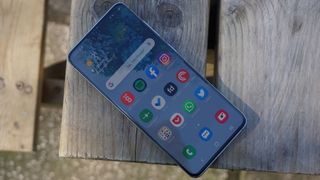
Also, the Galaxy S20 sports a higher refresh rate: 120Hz as opposed to the Pixel 5’s 90Hz. Both feel fast and responsive in the hand, but the Galaxy S20 most certainly has the edge.
It’s worth mentioning that when the Galaxy S20’s 120Hz mode is active, the resolution drops to FHD, so it’s a bit of a leveler. But overall, Samsung wins the display round quite comfortably.
Camera
Google has long taken an uncommonly spartan approach to camera hardware, preferring to make advances through its formidable image processing algorithms. That approach largely continues with the Pixel 5, which sticks with the main 12.2MP Sony Exmor IMX363 sensor that’s been in use for several years.
However, this time around it has added a second camera into the mix in the form of a dedicated 16MP 107-degree ultra-wide. The Google Pixel 4 had an optical telephoto lens instead.
Google’s photography lead has eroded by quite a lot in recent years, so while the Pixel 5 still takes good pictures, it’s no longer markedly better than its rivals - including the Samsung Galaxy S20.
The Pixel 5 excels in low light where it captures impressively accurate colors. Its ultra-wide lens also creates a lot less distortion at the edges than images captured with similar lenses on other phones. Google’s built-in image editing software is among the best in the business, too.
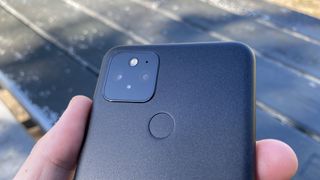
While Google’s camera strength lies in its software, Samsung’s is in hardware. The Samsung Galaxy S20 packs in three cameras: a 12MP wide, 64MP telephoto, and 12MP ultra-wide. That high-megapixel telephoto provides lossless 3x zoomed shots, which the Pixel 5 can’t get anywhere near.
What’s more, the main sensor is much larger than the Pixel 5’s, producing huge 1.8 µm pixels next to the Pixel 5’s 1.4 μm. This means that it captures more light than its rival, and doesn’t have to work that limited image data quite so hard.
Samsung isn’t finished with its advanced camera tech. The Galaxy S20 is one of few phones capable of shooting 8K footage, where the Pixel 5 is left with 4K video at 60fps.
Google might well ask who actually needs to shoot at 8K, or who has an 8K TV or monitor to watch it back on, and we’d be inclined to agree. Especially when you lose out on Samsung’s advanced stabilization tech at anything above 1080p, and when that 8K resolution only comes at a ‘cinematic’ 24fps.
Mobile photography is about much more than flashy features, of course, and we still prefer Google’s bright, clear, even color science over Samsung’s poke-you-in-the-eye tones in general shooting conditions. But the Galaxy S20 camera is much more flexible.
Specs and performance
So far, we’ve seen Google and Samsung take very different approaches with their 2020 flagship phones. And that difference comes into sharp focus when you consider the matter of performance.
Samsung has gone with top-end chips for the Galaxy S20. The Snapdragon 865 found in the company’s US handsets has been the go-to high-end chip for almost the whole of 2020.
However, Samsung gets a black mark against its name for using its own Exynos 990 chipset in the global Galaxy S20. This chip is still a high-end performer, but it doesn’t match up to any rival phone using the Snapdragon 865.

Fortunately for Samsung, in this comparison piece at least, the Pixel 5 isn’t one of those rival phones. Google’s major decision with its current champ was to move away from the hardware arms race and deliver a phone that gives an approximate flagship experience at half the price.
This was made possible by the Snapdragon 765G - an upper-mid-range chip that handles all tasks very well, and with excellent energy-efficiency, but at a much lower cost.
It’s not as fast as true flagship phones. Even the Galaxy S20’s underwhelming Exynos 990 outperforms it. A Geekbench 5 multicore score of 2699 might fall short of its Snapdragon 865 cousins, but the Exynos trounces the Snapdragon 765-driven Pixel 5 on 1617.
In practical terms, gaming isn’t quite as silky smooth on the Pixel 5 as it is on the Galaxy S20. Otherwise, with both phones packing a respectable 8GB of RAM (12GB for the S20 5G), multitasking is reasonably snappy. Still, overall, the Galaxy S20 wins the performance round quite handily.
One of the few similarities between these two phones is that they come with just a single 128GB storage option. But even here, the Galaxy S20 offers the possibility of up to 1TB of microSD card expansion, whereas the Pixel 5 offers none.
Just about the only area in which the age difference between these two phones manifests itself is in their approach to 5G. The Galaxy S20 arrived early in 2020, when 5G was seen as an optional extra. The Pixel 5 came along at the end of 2020, when every single mid to high-end phone was expected to have 5G connectivity.
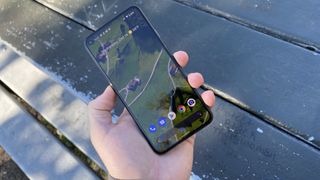
As a result, you have to buy the more expensive Samsung Galaxy S20 5G if you want next generation connectivity. The Pixel 5 comes with 5G as standard.
Another win for the Pixel 5 is software. We’ve long espoused the delights of a pure Android experience, and they don’t come purer than the Pixel 5. It’s Android as Google envisaged it, with no superfluous third-party apps and nice clean menus.
Conversely, Samsung’s One UI has always been somewhat divisive. We know it has its fans (as Samsung’s ongoing popularity attests to), and it’s certainly a bright and flexible interface. But it undoubtedly offers way more bloatware and clutter than its rival, too.
Matters of UI preference aside, if you want a timely upgrade to Android 12 when it arrives, the Pixel 5 is the phone for you. Samsung Galaxy S20 owners only started to get their Android 11 updates through at the very end of 2020.
Battery
The Samsung Galaxy S20 has a 4,000mAh battery, while the Google Pixel 5 has a 4,080mAh cell. That’s a rare similarity.
Both are good for a full day of moderate to heavy usage with plenty to spare, and both phones have advanced battery saver modes for when things get a little hairy.
Overall, though, the Pixel 5 lasts longer on a single charge. You can probably thank the combination of a smaller, less demanding 90Hz display and a more efficient processor for this.
Both phones support reverse wireless charging too, so you can both charge wirelessly and charge other devices wirelessly through them.
In speed terms, the Galaxy S20 does things faster. It supports 15W wireless charging versus the Pixel 5’s 12W, and 25W wired charging against the Pixel 5’s 18W.
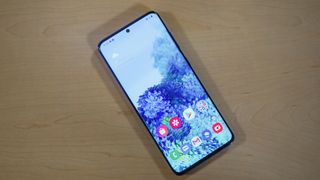
Takeaway
Launched at opposite ends of 2020, these two phones demonstrate very different approaches to a rapidly changing smartphone market.
The Samsung Galaxy S20 is a classic flagship smartphone, with some top notch specs and an eye-catching design. Its triple camera system is highly flexible, and as is always the case with Samsung phones, it’s not left wanting on the feature count.
By contrast, Google has actively stepped back from the Android flagship arms race that Samsung has dominated for so long, and instead seeks to offer a roughly flagship-approximating experience for two thirds of the RRP.
Smart use of a slightly lesser chipset and recycled camera components, as well as a workmanlike all-metal design and a good but not top-tier display, mean that it can mix it with the Galaxy S20 without quite hitting the same heights.
If you can find the Samsung Galaxy S20 for a hefty discount, it’s clearly a better pick than the Google phone. But as we head towards the launch of the Samsung Galaxy S21, stock for Samsung’s long-in-the-tooth phone is growing scarcer.
This makes the Google Pixel 5, with its solid availability, predictable pricing, and promise of speedy software updates, a safer bet for the near future.
- Check out all the other best smartphones
